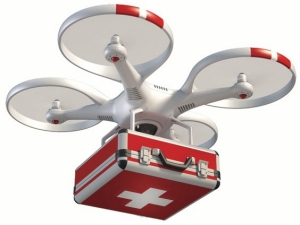Drones to the Rescue

By Justin Kovach
In times of war, the ability to get injured soldiers from the battlefield safely back for medical treatment without risking another life is priceless.
Normally a soldier would call for medical evacuation for a wounded comrade, which usually takes place by a manned helicopter flight. The only problem with this type of evacuation is that it puts additional lives in danger, namely the pilots. But in our ever-increasing world of autonomous vehicles, this problem may soon disappear.
The Hero Named K-MAX
K-MAX is a power-lift helicopter manufactured by Kaman Aerospace that was converted to an unmanned cargo helicopter, successfully completing over 1,900 resupply operations in combat situations between 2011 and 2014. In March of 2015, K-MAX started doing casualty evacuation testing. Because of K-MAX’s twin-rotor design that optimizes lift capabilities, it can fly in weather that would normally ground manned flights. With less restrictive flight obstacles and no possibility of human life being lost by sending a rescue helicopter, it is no wonder the U.S. Military is interested in unmanned rescue drones. FAA (Federal Aviation Administration) regulations currently require a pilot for any flights involving humans, but those laws may change in the future when the technology of K-MAX and other such unmanned vehicles, like autonomous drones, start flying in our everyday airspace.
A Drone Cab from Your iPad
K-MAX isn’t the only unmanned vehicle out there trying to safely fly humans around. A Chinese startup called EHang recently unveiled a drone dubbed Ehang 184. Unlike the unmanned K-MAX, Ehang 184 is autonomous. It’s a quadcopter capable of carrying a single passenger on a 23-minute flight at a speed of approximately 62 miles per hour. Using a tablet, the passenger can set the destination, take off and land while everything else is handled by the autonomous system in the drone. EHang is hopeful that its air taxis can hit the markets in 2016, though it will be a little longer before they would arrive in the U.S.
Classroom Discussion
- What risks are involved in autonomous rescue vehicles and public transit?
- What problems will likely arise have when it comes to accepting and regulating driverless sky taxis?
- Would you trust your life to a computer in the sky?
- What does the Federal Aviation Administration do?
Vocabulary
- Autonomous
- Quadcopter
- Expeditiously